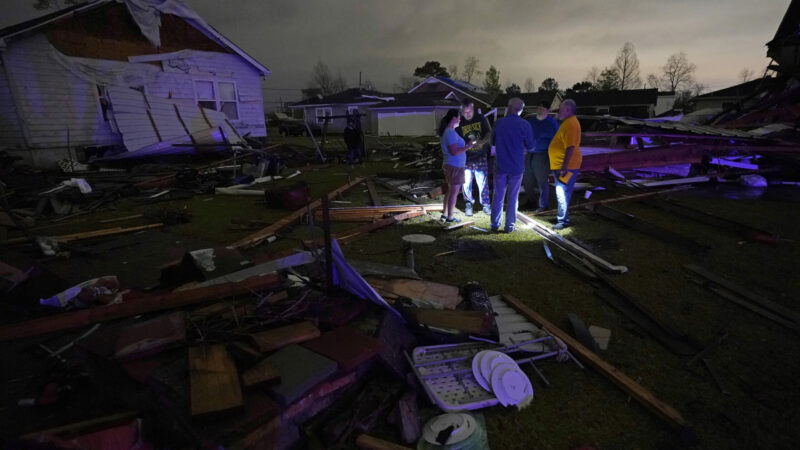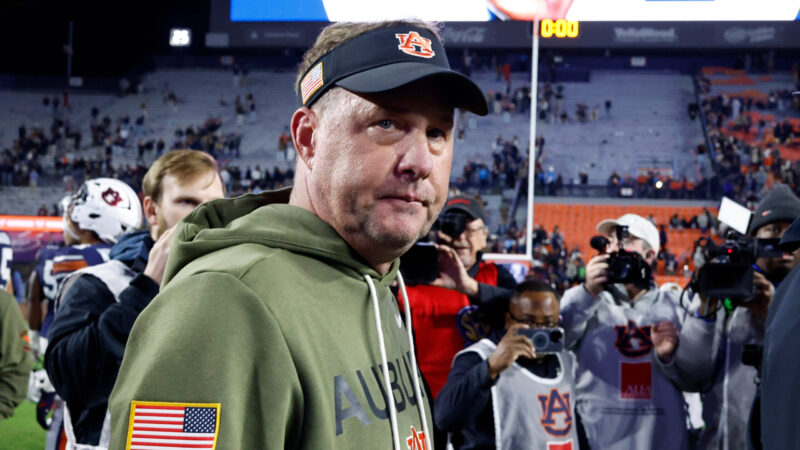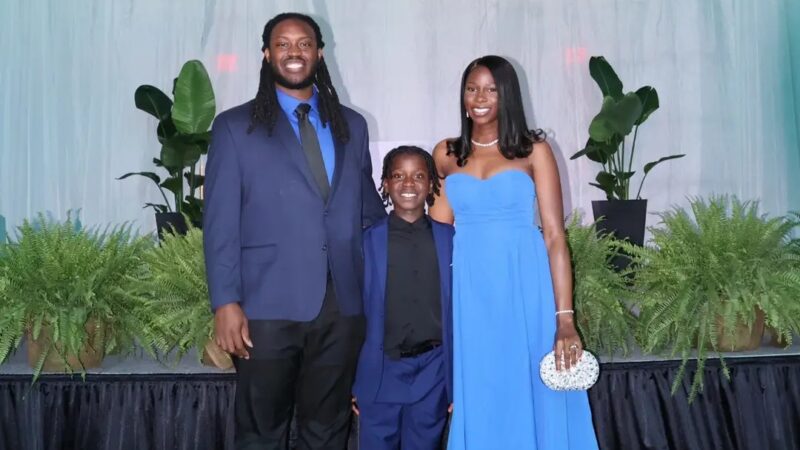EXPLAINER: Why the South gets more killer tornadoes at night
Christine Wiecek, left, and her husband Robert Patchus, second left, talk to neighbors amongst debris of their damaged homes after a tornado struck the area in Arabi, La., Tuesday, March 22, 2022. A tornado tore through parts of New Orleans and its suburbs Tuesday night, ripping down power lines and scattering debris in a part of the city that had been heavily damaged by Hurricane Katrina 17 years ago.
By SETH BORENSTEIN AP Science Writer
Forget “The Wizard of Oz.” Tornadoes are causing far more deaths and destruction east and south of Kansas these days. And they’re often doing it in the dark of night.
Tuesday night’s deadly tornado that struck the New Orleans area is the ideal example of what experts say is the 21st century problem with twisters: Killer tornadoes have shifted a bit out of the vast emptiness of the Great Plains, more into the Southeast where there are more people to hit, poorer populations and more trees to obscure twisters from view.
And if that’s not enough, these Southeast twisters are more likely to strike at night when they are more dangerous.
Here’s a closer look at what’s behind the shift:
Why are tornadoes killing more people outside the great plains?
Since 2000, nearly 89% of the 1,653 Americans killed by tornadoes — not counting this week’s victims — lived east of the Dakotas, Nebraska, Kansas, Oklahoma and Texas, according to an Associated Press analysis of National Oceanic and Atmospheric Administration data.
Last year, 100 people were killed by tornadoes in Kentucky, Alabama, Illinois, Tennessee, North Carolina, Arkansas, Missouri, Louisiana, Mississippi and Pennsylvania. One person was killed in Texas.
It’s not so much a meteorology problem but a people one, tornado experts said.
“It’s a function of the human-built environment,” said Victor Gensini, a professor of meteorology at Northern Illinois University who specializes in severe storms. “The Mid-South does get a lot of tornadoes, but in the Mid-South we have more things to hit. We have more bull’s eyes on the dartboard. We have more cities. We have more weak frame housing stock. Tornadoes happen more often there at night, which is exactly what we saw last night.”
Harold Brooks, a senior scientist at NOAA’s National Severe Storms Laboratory, said traditional 20th century tornadoes, the type that make Oklahoma and Kansas famous, are less deadly because they go for miles without anything in the way. In 1991, he and his wife chased for 66 miles a tornado in Oklahoma that had winds hit 286 mph. It hit two barns; no one but a few cows were hurt.
Put that storm near New Orleans at night and dozens of people would be killed, probably many more. In the Southeast “all it takes is a weather event to occur and you’ll have people in the way,” Brooks said.
Does climate change have a role?
In 2018, Brooks and Gensini published a scientific study showing deadly tornadoes were happening less frequently in the tornado alley of Oklahoma, Kansas and Texas and more frequently in “tornado fatality alley, which is the Mid-South,” Gensini said.
What’s likely happening is that the West is getting drier because of human-caused climate change, which makes it harder for the air to become moist and unstable, which is crucial for tornado formation, they said. The Southeast is getting warmer air, which holds more water vapor, which creates that important instability, Gensini said.
Climate models predict this type shift 50 years in the future or so, yet it appears to be happening now, Gensini said.
But Gensini, Brooks and University of Ohio meteorology professor Jana Houser emphasized that they don’t see a climate change signal in Tuesday’s deadly Louisiana tornado.
There’s a La Nina, a natural periodic cooling of parts of the Pacific that shifts global weather patterns, and that usually means more tornadoes in the Southeast because of changes in the jet stream and moisture, they said.
What’s different about night tornadoes?
Tuesday’s nighttime tornado illustrated a problem because when twisters hit at night, people can’t see them coming as easily and often don’t react as well, the tornado experts said.
About three-quarters of the tornadoes that hit Oklahoma and other Great Plains states occur between 5 and 9 p.m. so people know when to expect them and its more daylight, Brooks said. But in the Southeast they can hit any time, which means more often at night than in Oklahoma, making them more dangerous.
Another reason they happen more at night in the Southeast is because they happen more in the springtime and there are just fewer daylight hours, Gensini said. Spring storms are juicier and stronger than summer ones so they don’t need the sun’s daytime heat to add that extra kick of energy to spur tornadoes, he said.
What about the landscape?
The Southeast is also hurt by having more trees, hills and buildings that block people’s views of incoming storms.
When there’s a tornado warning in the Southeast, often people are “out to their front porch and they don’t really see anything, and it just kind of looks like, you know, a dark sky,” Houser said. “They may be less likely to actually heed those warnings than if they are walking out their door and they see a tornado on the horizon, even if it’s far away. So there’s a little bit of geography that plays a role there.”
Any good news for the region?
The one advantage tornadoes in the Southeast have is that they are easier for meteorologists to forecast the conditions ripe for bad outbreaks much earlier. Tuesday’s severe storm was warned about eight days in advance by NOAA’s Storm Prediction Center, which is unusual, Brooks said.
Auburn fires coach Hugh Freeze following 12th loss in his last 15 SEC games
The 56-year-old Freeze failed to fix Auburn’s offensive issues in three years on the Plains, scoring 24 or fewer points in 17 of his 22 league games. He also ended up on the wrong end of too many close matchups, including twice this season thanks partly to questionable calls.
In a ‘disheartening’ era, the nation’s former top mining regulator speaks out
Joe Pizarchik, who led the federal Office of Surface Mining Reclamation and Enforcement from 2009 to 2017, says Alabama’s move in the wake of a fatal 2024 home explosion increases risks to residents living atop “gassy” coal mines.
‘It’s like feeling the arms of your creator just wrapped around you’: a visit to a special healing Shabbat
Members of Temple Emanu-El in Birmingham gathered recently for their traditional Friday Shabbat service. But this particular service was different, as could be seen by all the people dressed in their finest pink.
Space Command is coming to Huntsville. What might that mean for first-time homebuyers
While Huntsville has been a more affordable market than other growing cities, what’s it been like for those looking for their first home?
Colorado says relocation of Space Command to Alabama is ‘punishment’ for mail-in voting
The litigation announced by Colorado Attorney General Phil Weiser asks a federal judge to block the move as unconstitutional.
Breaking down Alabama’s CHOOSE Act
It’s been a year since Alabama legislators passed the CHOOSE Act allowing families to apply for state funds to use towards homeschool expenses and tuition for participating private schools. The Alabama Daily News’ education reporter Trisha Powell Crain has been diving into how the funds are being used. WBHM’s Andrew Gelderman sat down with her to talk about what we’re seeing so far.









